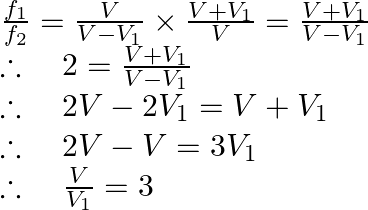Answer is (B)
![]()
Speed of approach ![]() Speed of leaving
Speed of leaving
The apparent frequency of sound level by observer when it is approaching source is given by
![]()
When observer is moving away from source
![]()
Here ![]() is the frequency of sound main
is the frequency of sound main
Taking ratios of (1) with (2) we have

When the observer moves towards the stationary source with velocity, ‘ ’, the apparent frequency of emitted note is ‘
’, the apparent frequency of emitted note is ‘ ’. When the observer moves away from the source with velocity ‘
’. When the observer moves away from the source with velocity ‘ ’, the apparent frequency is ‘
’, the apparent frequency is ‘ ’. If ‘
’. If ‘ ’ is the velocity of sound in air and
’ is the velocity of sound in air and  then
then 
A) 2
B) 3
C) 4
D) 5
A) 2
B) 3
C) 4
D) 5
When the observer moves towards the stationary source with velocity, ‘ ’, the apparent frequency of emitted note is ‘
’, the apparent frequency of emitted note is ‘ ’. When the observer moves away from the source with velocity ‘
’. When the observer moves away from the source with velocity ‘ ’, the apparent frequency is ‘
’, the apparent frequency is ‘ ’. If ‘
’. If ‘ ’ is the velocity of sound in air and
’ is the velocity of sound in air and  then
then 
A) 2
B) 3
C) 4
D) 5
A) 2
B) 3
C) 4
D) 5
